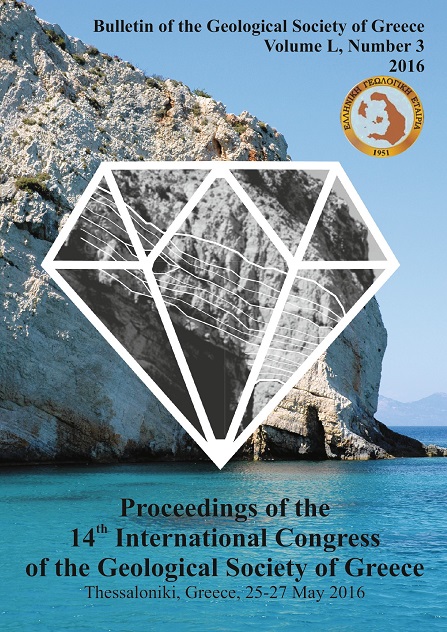ON THE EARTHQUAKE OCCURRENCES IN JAPAN AND THE SURROUNDING AREA VIA SEMI MARKOV MODELING

Περίληψη
Στην παρούσα εργασία, μελετάται η σεισμικότητα στην περιοχή της Ιαπωνίας με τη χρήση Ημιμαρκοβιανού μοντέλου για το οποίο υποθέτουμε ομογένεια ως προς τον χρόνο. Τα δεδομένα που χρησιμοποιήθηκαν, αφορούν μεγέθη ισχυρών σεισμών (Mw>6.0) για το χρονικό διάστημα 1900 - 2012. Ως χώρο καταστάσεων, θεωρήσαμε το καρτεσιανό γινόμενο των 11 ζωνών i Z στις οποίες χωρίζεται η Ιαπωνία, επί τις 3 τάξεις μεγέθους 1 R , 2 R , 3 R που αντιστοιχούν σε μεγέθη 6 7,7.1-8 and M> 8.0 αντίστοιχα. Λόγω του μικρού πλήθους δεδομένων στις ζώνες 9,10 και 11, έγινε σύμπτυξη σε μία ζώνη, την οποία συμβολίζουμε ως 9 Z . Σύμφωνα με αυτήν τη μοντελοποίηση περιγράφονται οι πιθανότητες μετάβασης ανάμεσα στα ζεύγη ( , )i j Z R i=1,...9, j=1,2,3, οι πιθανότητες μετάβασης σε διάστημα, και οι οριακές πιθανότητες. Τέλος, σχολιάζονται κάποια ενδιαφέροντα αριθμητικά αποτελέσματα. Το μήκος του χρονικού διαστήματος που έχει υπολογιστεί, φτάνει το μέγιστο τα 7 χρόνια το οποίο είναι αρκετό για να φτάσει το σύστημα στην οριακή του κατάσταση. Η χρονικη μονάδα στους υπολογισμούς ορίστηκε να είναι η μία μέρα.
Λεπτομέρειες άρθρου
- Πώς να δημιουργήσετε Αναφορές
-
Panorias, C., Papadopoulou, A., & Tsapanos, T. (2016). ON THE EARTHQUAKE OCCURRENCES IN JAPAN AND THE SURROUNDING AREA VIA SEMI MARKOV MODELING. Δελτίο της Ελληνικής Γεωλογικής Εταιρείας, 50(3), 1535–1542. https://doi.org/10.12681/bgsg.11866
- Ενότητα
- Σεισμολογία

Αυτή η εργασία είναι αδειοδοτημένη υπό το CC Αναφορά Δημιουργού – Μη Εμπορική Χρήση 4.0.
Οι συγγραφείς θα πρέπει να είναι σύμφωνοι με τα παρακάτω: Οι συγγραφείς των άρθρων που δημοσιεύονται στο περιοδικό διατηρούν τα δικαιώματα πνευματικής ιδιοκτησίας επί των άρθρων τους, δίνοντας στο περιοδικό το δικαίωμα της πρώτης δημοσίευσης. Άρθρα που δημοσιεύονται στο περιοδικό διατίθενται με άδεια Creative Commons 4.0 Non Commercial και σύμφωνα με την οποία μπορούν να χρησιμοποιούνται ελεύθερα, με αναφορά στο/στη συγγραφέα και στην πρώτη δημοσίευση για μη κερδοσκοπικούς σκοπούς. Οι συγγραφείς μπορούν να: Μοιραστούν — αντιγράψουν και αναδιανέμουν το υλικό με κάθε μέσο και τρόπο, Προσαρμόσουν — αναμείξουν, τροποποιήσουν και δημιουργήσουν πάνω στο υλικό.


